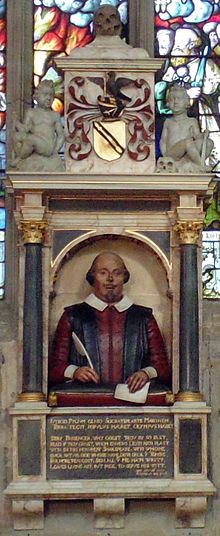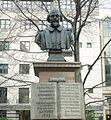Memorials to William Shakespeare

William Shakespeare has been commemorated in a number of different statues and memorials around the world, notably his funerary monument in Stratford-upon-Avon (c. 1623); a statue in Poets' Corner in Westminster Abbey, London, designed by William Kent and executed by Peter Scheemakers (1740);[1] and a statue in New York's Central Park by John Quincy Adams Ward (1872).[2][3]
17th century

Shakespeare's funerary monument is the earliest memorial to the playwright, located inside Holy Trinity Church, Stratford-upon-Avon, Warwickshire, UK, the same church in which he was baptised. The exact date of its construction is not known, but must have been between Shakespeare's death in 1616 and 1623, when it is mentioned in the First Folio of the playwright's works.
The monument, by Gerard Johnson, is mounted on a wall above Shakespeare's grave. It features a bust of the poet, who holds a quill pen in one hand and a piece of paper in another. His arms are resting on a cushion. Above him is the Shakespeare family's coat of arms, on either side of which stands two allegorical figures: one, representing Labour, holds a spade, the other, representing Rest, holds a torch and a skull.
18th century
As Shakespeare's reputation rose, monuments began to be created in nationally significant locations.

In 1757 the English actor David Garrick commissioned a marble statue of William Shakespeare from the French sculptor Louis-François Roubiliac for his Palladian Temple to Shakespeare at Hampton. Garrick himself is thought to have posed for the statue.[7] It was bequeathed, along with Garrick's books, to the British Museum in 1779; in 2005 it was transferred to the British Library.[8] Garrick later commissioned Roubiliac to produce a bust of the poet for his Shakespeare festival in Stratford in 1769;[9] this is now in the Garrick Club in London.[2]
In 1788, in the exterior wall of
19th century
By the nineteenth century Shakespeare's reputation had advanced to the point of what came to be known as bardolatry. Statues and other memorials began to appear outside Britain, while in Britain itself Shakespeare's status as national poet was consolidated.
United States

New York City's Central Park contains a statue of Shakespeare that was commissioned in 1864 as a celebration of the tricentenary of Shakespeare's birth in 1564. Funds were raised by a performance of Julius Caesar in which Edwin Booth took the lead role, with John Wilkes Booth playing Mark Antony.[12] The statue was designed by John Quincy Adams Ward. Following the creation of the statue, in 1873 commissioners proposed that the Mall should be a designated location for sculpture and the statue was moved there, soon to be accompanied by others[13] (in 1986, a replica of the statue was made for the State Theater in Montgomery, Alabama, which has a yearly Shakespeare Festival).[14]
In 1888, a large seated statue by William Ordway Partridge was unveiled in Lincoln Park, Chicago and in 1896 a bronze statue of Shakespeare by Frederick William MacMonnies was erected as part of a series representing the world's geniuses in the gallery of the reading-room of the Library of Congress.
Britain

With the removal of Banks's sculpture to New Place in 1871 London boasted no outdoor public memorial to the bard, and the erection of the New York statue in 1872 made this omission particularly glaring. In 1874 the financier Baron Albert Grant, wishing to address this situation, installed a fountain with a marble statue of Shakespeare at its centre in the gardens of Leicester Square. Sculpted by Giovanni Fontana, this was a replica of Scheemakers's monument in Poets' Corner.[15] Another statue was erected in Stratford, London, a suburb with the same name as Shakespeare's home town.
In 1877 a committee was created in
Other countries
Though most memorials are to be found in English speaking countries, there are also monuments elsewhere. In 1888 a statue was erected on the Boulevard Haussmann in Paris, designed by Paul Fournier.[16]
20th century
Britain

Between 1970 and 1993, an image of the Poets' Corner statue of Shakespeare appeared on the reverse of Series D £20 notes issued by the Bank of England. Alongside the statue was an engraving of the balcony scene from Romeo and Juliet.[17][18]
A complex memorial to Shakespeare was created in Southwark Cathedral, which was his parish church when he lived in London close to the Globe Theatre. It is also the burial place of Shakespeare's brother Edmund, along with other Elizabethan actors and playwrights. A recumbent statue of Shakespeare, created by Henry McCarthy in 1912, was placed in a niche on which was carved images of Elizabethan Southwark depicting the Globe, Winchester Palace and the tower of the church. An elaborate stained glass window was also created, depicting Shakespearean characters. The original window was destroyed by a bomb blast in World War II but was replaced in 1954. A birthday celebration of Shakespeare is held every year in April.[19]
Continental Europe

Despite Germany's early role in canonising Shakespeare it was not until 1904 that a statue was erected in Weimar showing him, as one critic has put it, "seated and staring into the distance with a bemused and thoughtful look".[20] It was designed by Otto Lessing.
In Denmark, a memorial statue was commissioned to commemorate the 300th anniversary of the publication of
Australia

A memorial in Sydney, Australia was erected in 1926, designed by Australian sculptor
Though initiated in 1889, the project to create a Shakespeare statue in Ballarat was not completed until 1960. Financial problems led to repeated shelving of the project. Eventually private donations to the fund produced sufficient resources to commission a bronze sculpture from Andor Meszaros, an Australian artist originally from Hungary. The statue depicts Shakespeare bowing, as if at the end of a performance.
North America
A statue was created for
A statue made from tin was erected in the gardens outside the Festival Theatre, the principal theatre on the grounds of the
Gallery
-
In 1864 a Shakespeare penny memorial poster stamp to commemorate the tercentenary of his birth was sold to raise funds for the Memorial Theatre at Stratford upon Avon.
-
A bust of Shakespeare in theJohn Heminge and Henry Condell, editors of the First Folio).
-
Copy of the Poets' Corner statue in Leicester Square, London
-
Shakespeare statue in Stratford, Ontario.
-
Shakespeare memorial, Logan Circle, Philadelphia, PA. Designed by Alexander Stirling Calder, 1923–26.
-
William Parker Ordway's statue in Chicago.
-
Ordway's statue from another angle.
-
Memorial in Southwark Cathedral, London
-
This bust is placed on the city gate of Verona, with lines from Romeo and Juliet stating "there is no world without Verona walls..."
-
Bust of Shakespeare on the National Theatre building, Hviezdoslav Square, Bratislava.
-
Stained glass at Ottawa Public Library features Charles Dickens, Archibald Lampman, Duncan Campbell Scott, Lord Byron, Alfred, Lord Tennyson, William Shakespeare, Thomas Moore
-
Coade stone statue of Shakespeare at Bonaly Tower, Edinburgh
See also
- Shakespeare's reputation
- Portraits of Shakespeare
Notes
- ^ "William Shakespeare". Westminster Abbey. Retrieved 19 April 2012.
- ^ a b "Memorials and Statues of William Shakespeare". Retrieved 17 October 2008.
- ^ "William Shakespeare statue". New York City Department of Parks & Recreation. 12 February 2007. Retrieved 22 October 2008.
- ^ Avery, Emmett L. (1956). "The Shakespeare Ladies Club". Shakespeare Quarterly 7 (2): p. 157
- ISBN 0198183232.
- ^ Raymond McKenzie, Gary Nisbet, Public Sculpture of Glasgow, Liverpool University Press, 2001, p. 434
- ^ "Marble full-length figure of William Shakespeare by Louis-François Roubiliac". British Museum. Retrieved 11 November 2013.
- ^ Howes, Jennifer (11 November 2013). "The Shakespeare sculpture at the British Library". English and Drama blog. British Library. Retrieved 11 November 2013.
- ^ Michael Dobson The Making of the National Poet: Shakespeare, Adaptation and Authorship, 1660–1769, Oxford University Press, p. 6
- ^ Sheppard, 325–38.
- ^ William Shakespeare, Hamlet. Act I, scene ii. Wikisource. Retrieved on 15 January 2008.
- ^ Villanova Magazine Archive – Winter 2001. Archived 29 August 2006 at the Wayback Machine It is sometimes mistakenly said that John Wilkes Booth played Cassius, cf. Frederick Wagner, American Actors and Actresses, Dodd Mead Company, New York, 1961.
- ^ a b "Shakespeare Memorials". William-shakespeare.info. Retrieved 10 December 2011.
- ^ "William Shakespeare Statue, New York City department of Parks and Recreation". Nycgovparks.org. 12 February 2007. Retrieved 10 December 2011.
- ^ Ward-Jackson, Philip (2011). Public Sculpture of Historic Westminster: Volume 1. Liverpool University Press., pp. 114–15
- ^ "Statue of Shakespeare (1564–1616) on Boulevard Haussmann, unveiled in 1888". Scholarsresource.com. Retrieved 10 December 2011.
- ^ "What Did Shakespeare Look Like?". The Shakespeare Birthplace Trust. Archived from the original on 14 October 2008. Retrieved 17 October 2008.
- ^ "Withdrawn Banknotes Reference Guide". Bank of England. Archived from the original on 10 June 2011. Retrieved 22 October 2008.
- ^ "Southwark Cathedral – Shakespeare Memorial". Southwark.anglican.org. Archived from the original on 24 September 2015. Retrieved 10 December 2011.
- ^ Stephen Kinzer, "Shakespeare, Icon in Germany" New York Times, 30 December 1995
- ^ "American Dramatic Pilgrimage to the Tomb of Hamlet", New York Times, 20 January 1907.
- ^ Patricia Vance, Intimate bicycle tours of Philadelphia: ten excursions to the city's art, University of Pennsylvania Press, 2004, P.64.














